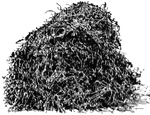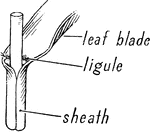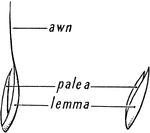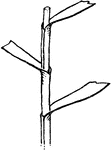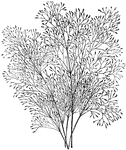
Agrostis Nebulosa Grass
Agrostis nebulosa is known as cloud grass. The flower clusters resemble a cloud resting over the ground.

Anthoxanthum Odoratum Grass
Anthoxanthum Odoratum is commonly known as Spring Grass. This grass grows up to one foot high. This…
Bouquet holder
"Bunch together seven fine, strong seed-grass stalks and tie just below the blossoms, with the root-end…
Bouquet of wild grasses
"Bunch together seven fine, strong seed-grass stalks and tie just below the blossoms, with the root-end…

Carex
Carex is a genus of plants in the family Cyperaceae, commonly known as sedges (although other, related…
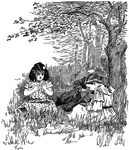
Children sitting in orchard
A small group of children sitting in an orchard playing with the wild grasses.

Cyperus
An illustration of the partial inflorescence of a cyperus plant, spikelet of the same (left), and the…

Esparto Grass
"Esparto-Grasses. 1, 4, stalk and fruit of Macrochloa tenacissima. 2, 3, 5, stalk, flowering stem, and…
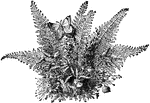
Design with Ferns
"It is made of pressed ferns, grasses, and flowers, with a beautifully colored Butterfly made of paper.…
Foxtail Grass
"Foxtail grass, the common name given to certain grasses, because of the shape of the large clusters…

Grass of Parnassus
A grass of Parnassus is any member of the genus Parnassia, of the Saxifrage family, growing in damp…

Annual Spear Grass
Spear grass is a herbaceous grass often troublesome in gravel walks and on hard, dry soils. The general…
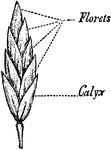
Annual Spear Grass
Spear grass is a herbaceous grass often troublesome in gravel walks and on hard, dry soils. The general…
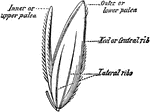
Annual Spear Grass
Spear grass is a herbaceous grass often troublesome in gravel walks and on hard, dry soils. The general…
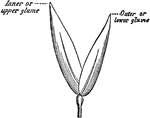
Annual Spear Grass
Spear grass is a herbaceous grass often troublesome in gravel walks and on hard, dry soils. The general…

Annual Spear Grass
Virginia Cut Grass (Leersia Virginica) is a small flowered white grass, and is smoother than white grass…
Barley
Barley is a cereal grain derived from the annual grass Hordeum vulgare, a common barley. It serves as…

Barley
Barley is a cereal grain derived from the annual grass Hordeum vulgare, a common barley. It serves as…
Beach Grass
Beach Grass (Calamagrostis arenaria or Ammophila arundinacea), also known as Seasand Reed and Mat Grass,…
Bearded Darnel
The Bearded Darnel (Lolium temulentum) is sometimes found in grain-fields, with its glume equalling…
Black Oat Grass
Black Oat Grass (Stipa avenacea) is found in dry, sandy woods and has no agricultural value. It grows…

Black Oat Grass
Black Oat Grass (Stipa avenacea) is found in dry, sandy woods and has no agricultural value. It grows…
Chess Grass
The Chess Grass (Bromus secalinus), also called Willard's Bromus, has a spreading, slightly drooping…
Chess Grass
The Chess Grass (Bromus secalinus), also called Willard's Bromus, has a spreading, slightly drooping…

Chess Grass
The Chess Grass (Bromus secalinus), also called Willard's Bromus, has a spreading, slightly drooping…
Chess Grass
The Chess Grass (Bromus secalinus), also called Willard's Bromus, has a spreading, slightly drooping…

Chinese Sugar Cane
The stem of Chinese Sugar Cane (Sorghum nigrum), also known as Sorgho, or Sorgho Sucre, rises from six…
Common Millet
The Common Millet (Panicum miliaceum) flowers in large, open, nodding panicles. The leaves are lance-shaped…
Couch Grass
Couch Grass (Triticum repens) is also referred to as Quitch Grass, Twitch Grass, Dog Grass, and Chandler…

Couch Grass
Couch Grass (Triticum repens) is also referred to as Quitch Grass, Twitch Grass, Dog Grass, and Chandler…
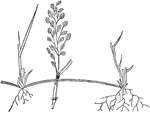
Creeping Meadow Grass
Creeping Meadow Grass (Eragrostis reptans) is found on the gravelly banks of rivers, from New England…
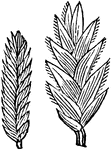
Creeping Meadow Grass
Creeping Meadow Grass (Eragrostis reptans) is found on the gravelly banks of rivers, from New England…

Creeping Meadow Grass
Creeping Meadow Grass (Eragrostis reptans) is found on the gravelly banks of rivers, from New England…

Creeping Meadow Grass
Creeping Meadow Grass (Eragrostis reptans) is found on the gravelly banks of rivers, from New England…

Creeping Meadow Grass
Creeping Meadow Grass (Eragrostis reptans) is found on the gravelly banks of rivers, from New England…

Creeping Meadow Grass
Creeping Meadow Grass (Eragrostis reptans) is found on the gravelly banks of rivers, from New England…

Creeping Soft Grass
The Creeping Soft Grass (Holcus mollis) is of no value, and is regarded as a troublesome weed. It is…
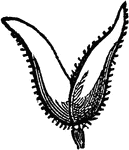
Creeping Soft Grass
Creeping Soft Grass or Creeping Velvet Grass is a species of grass, native to Europe and western Asia.
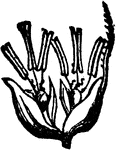
Creeping Soft Grass
It is favored by conditions in woodland clearings and at the earl stages of coppicing. Growth and flowering…
Crested Dog's Tail
The spikes of the Crested Dog's Tail Grass (Cynosurus cristatus) are simple and its spikelets awnless.…
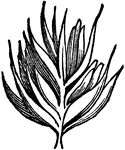
Crested Dog's Tail
The spikes of the Crested Dog's Tail Grass (Cynosurus cristatus) are simple and its spikelets awnless.…
Downy Oat Grass
The Downy Oat Grass (Trisetum pubescens) is naturalized in chalky soils and on such soils its leaves…
Finger-spiked Wood Grass
Fiinger-spiked Wood Grass (Andropogon furcatus) grows about four feet high. The leaves are smooth, the…

Finger-spiked Wood Grass
Fiinger-spiked Wood Grass (Andropogon furcatus) grows about four feet high. The leaves are smooth, the…

Finger-spiked Wood Grass
Fiinger-spiked Wood Grass (Andropogon furcatus) grows about four feet high. The leaves are smooth, the…

Finger-spiked Wood Grass
Fiinger-spiked Wood Grass (Andropogon furcatus) grows about four feet high. The leaves are smooth, the…

Fiorin Grass
Fiorin Grass (Agrostis stolonifera) is a variety of English bent. In experiments it was found to be…

Fiorin Grass
Fiorin Grass (Agrostis stolonifera) is a variety of English bent. In experiments it was found to be…
Floating Foxtail Grass
The Floating Foxtail (Alopecurus geniculatus) has a stem ascending, bent, and forming knees at the lower…

Floating Foxtail Grass
The Floating Foxtail (Alopecurus geniculatus) has a stem ascending, bent, and forming knees at the lower…
Floating Meadow Grass
Floating Meadow Grass (Glyceria fluitans), also know as Common Manna Grass, grows in very moist muddy…
Floating Meadow Grass
Floating Meadow Grass (Glyceria fluitans), also know as Common Manna Grass, grows in very moist muddy…

Fowl Meadow
Fowl Meadow Grass (Poa serotina), also called False Redtop, has two to four spikelets (shown here),…

Fowl Meadow
Fowl Meadow (Poa serotina), also called False Redtop, has two to four spikelets, sometimes five flowered.…

Fowl Meadow
Fowl Meadow (Poa serotina), also called False Redtop, has two to four spikelets, sometimes five flowered.…
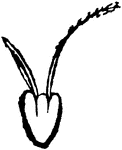
Fowl Meadow
Fowl Meadow (Poa serotina), also called False Redtop, has two to four spikelets, sometimes five flowered.…
